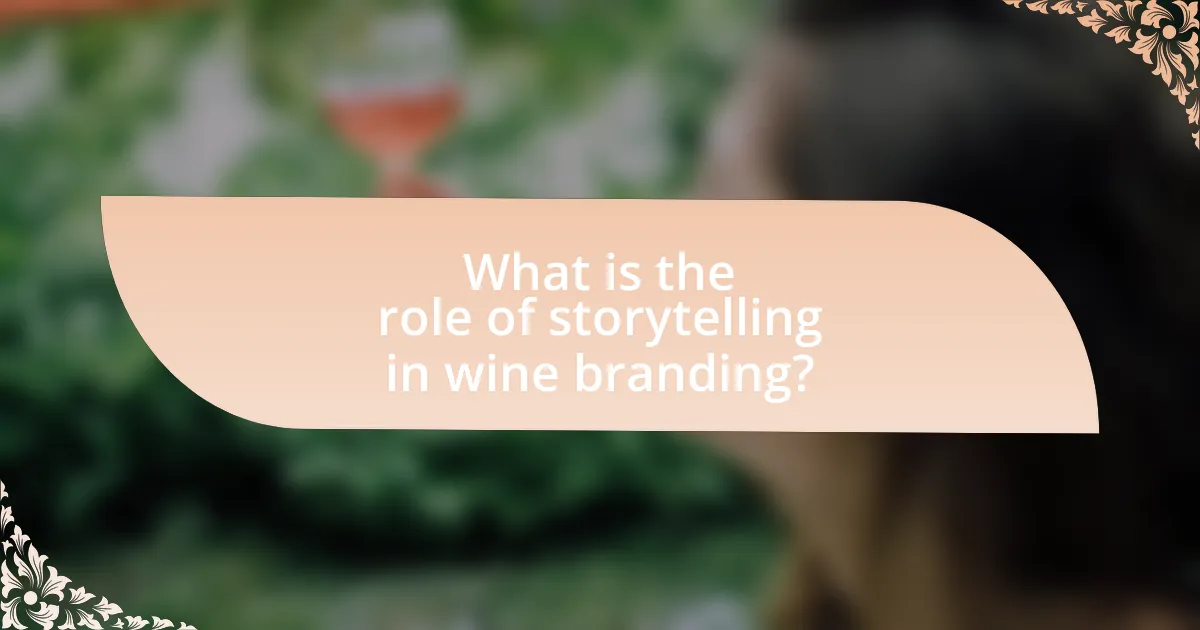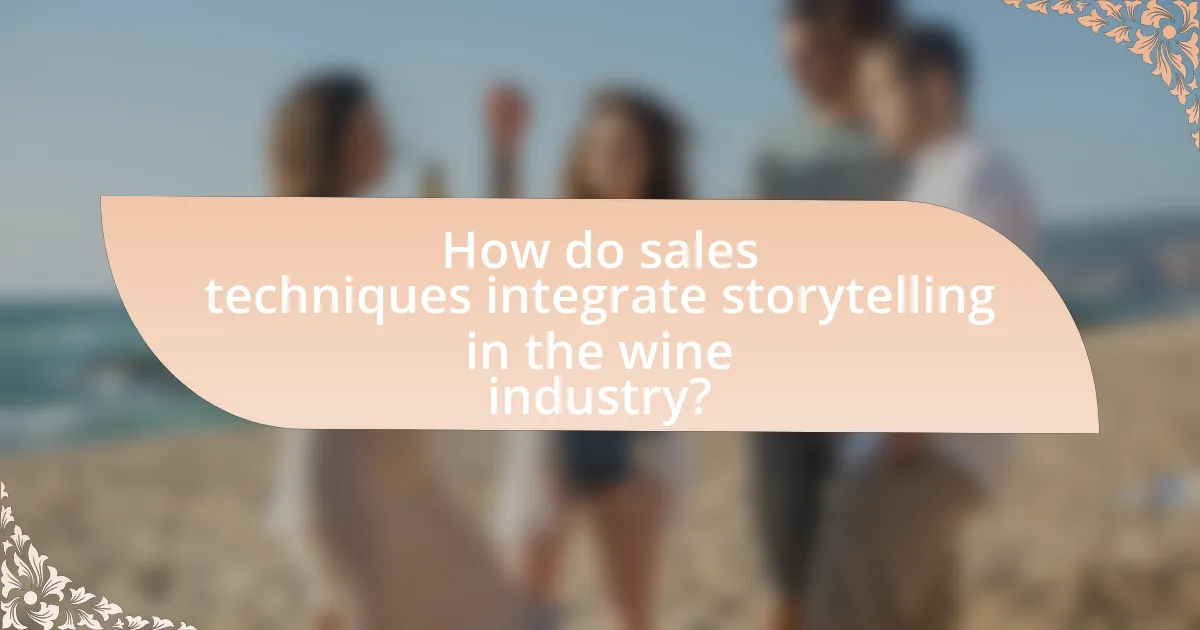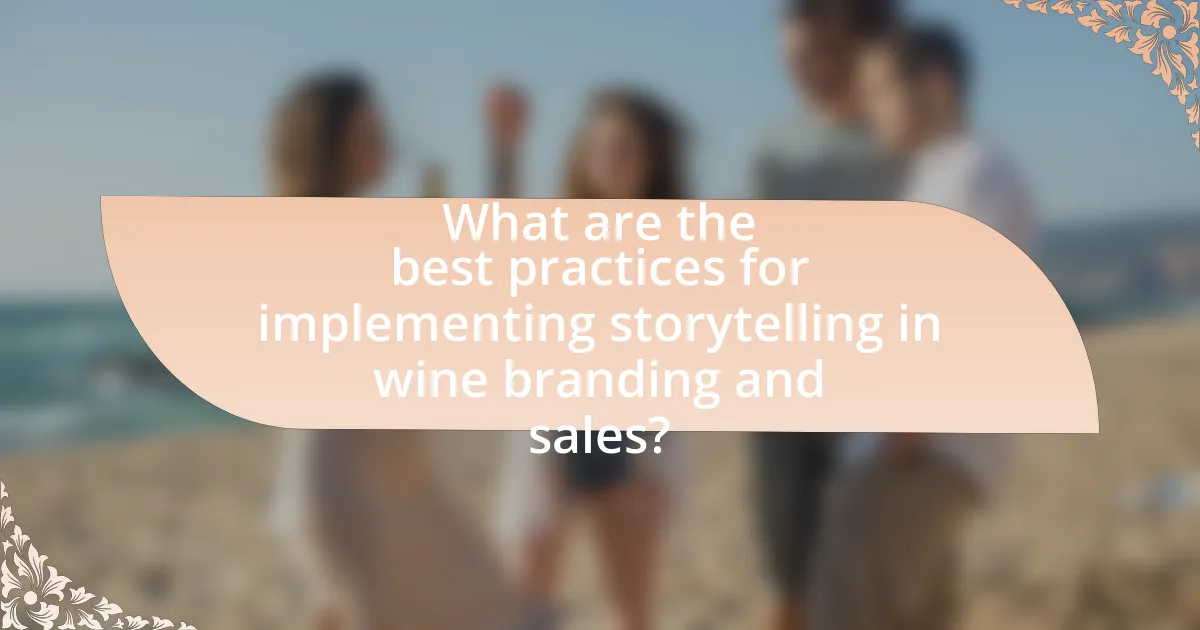The article examines the critical role of storytelling in wine branding and sales techniques, emphasizing how narratives create emotional connections between consumers and brands. It highlights the importance of authenticity, heritage, and emotional engagement in enhancing brand perception and loyalty. Key elements discussed include effective storytelling techniques, the psychological impact of narratives on purchasing decisions, and best practices for wineries to develop and communicate their unique brand stories. The article also addresses common pitfalls to avoid and strategies for ensuring that storytelling resonates with target audiences, ultimately driving sales and customer retention in a competitive market.

What is the role of storytelling in wine branding?
Storytelling plays a crucial role in wine branding by creating emotional connections between consumers and the brand. This connection enhances brand loyalty and differentiates products in a competitive market. For instance, brands that share their heritage, winemaking processes, or unique vineyard stories often see increased consumer engagement and willingness to pay premium prices. Research indicates that storytelling can increase perceived value; a study by the Journal of Consumer Research found that narratives can enhance product evaluation and preference. Thus, effective storytelling not only enriches the consumer experience but also drives sales and brand recognition in the wine industry.
How does storytelling enhance the perception of a wine brand?
Storytelling enhances the perception of a wine brand by creating emotional connections and conveying authenticity. When a wine brand shares its origin story, production methods, or the passion behind its creation, it fosters a deeper relationship with consumers, making the brand more relatable and memorable. Research indicates that brands with compelling narratives can increase consumer loyalty by up to 55%, as stories evoke emotions that influence purchasing decisions. This emotional engagement not only differentiates the brand in a crowded market but also enhances perceived value, leading to higher sales and customer retention.
What elements of storytelling resonate with consumers in the wine industry?
Elements of storytelling that resonate with consumers in the wine industry include authenticity, heritage, and emotional connection. Authenticity allows consumers to trust the brand, as they seek genuine narratives about the wine’s origin and production process. Heritage emphasizes the history and tradition behind the wine, appealing to consumers’ appreciation for craftsmanship and legacy. Emotional connection engages consumers on a personal level, often through relatable stories about the winemaker or the vineyard’s journey, which can enhance brand loyalty. Research indicates that brands that effectively communicate their story can increase consumer engagement and sales, as narratives create memorable experiences that resonate with buyers.
How can a compelling narrative differentiate a wine brand in a crowded market?
A compelling narrative can differentiate a wine brand in a crowded market by creating an emotional connection with consumers, which enhances brand loyalty and recognition. This connection is established through storytelling that highlights the brand’s heritage, unique production methods, or the personal journey of the winemaker. For instance, brands like Château Margaux leverage their historical significance and winemaking traditions to attract consumers who value authenticity and craftsmanship. Research indicates that 55% of consumers are more likely to purchase a product when they feel a connection to its story, demonstrating the effectiveness of narrative in influencing buying decisions.
Why is emotional connection important in wine branding?
Emotional connection is crucial in wine branding because it fosters loyalty and enhances consumer engagement. When consumers feel an emotional bond with a brand, they are more likely to choose that brand over competitors, leading to increased sales and brand advocacy. Research indicates that brands that successfully evoke emotions can achieve a 23% increase in sales compared to those that do not. This emotional resonance often stems from storytelling, which allows brands to convey their heritage, values, and unique experiences associated with their wines, making the brand more relatable and memorable to consumers.
How does storytelling evoke emotions in potential wine buyers?
Storytelling evokes emotions in potential wine buyers by creating a narrative that connects them to the product on a personal level. This emotional connection is often established through the sharing of the wine’s origin, the winemaker’s journey, and the unique characteristics of the vineyard, which can resonate with buyers’ values and experiences. Research indicates that consumers are more likely to purchase products that they feel a personal connection to; for instance, a study published in the Journal of Consumer Research found that narratives can enhance emotional engagement and increase purchase intentions. By effectively utilizing storytelling, wine brands can foster a deeper emotional bond, ultimately influencing buying decisions.
What are the psychological effects of storytelling on consumer purchasing decisions?
Storytelling significantly influences consumer purchasing decisions by enhancing emotional engagement and creating a memorable brand experience. When consumers connect emotionally with a narrative, they are more likely to develop trust and loyalty towards the brand, which can lead to increased sales. Research indicates that stories activate the brain’s sensory and emotional centers, making the information more relatable and persuasive. For instance, a study published in the Journal of Consumer Research found that consumers are more likely to purchase products when they are presented within a compelling narrative context, as it fosters a sense of connection and authenticity. This psychological effect underscores the importance of storytelling in marketing strategies, particularly in sectors like wine branding, where the narrative can evoke sensory experiences and cultural associations that enhance consumer appeal.

How do sales techniques integrate storytelling in the wine industry?
Sales techniques in the wine industry integrate storytelling by creating narratives around the wine’s origin, production process, and the people behind it. This approach enhances emotional connections with consumers, making the product more relatable and memorable. For instance, wineries often share stories about their vineyards, the unique terroir, and the winemakers’ passion, which can significantly influence purchasing decisions. Research indicates that storytelling can increase consumer engagement and brand loyalty, as evidenced by a study published in the Journal of Wine Research, which found that narratives about wine significantly impacted consumers’ perceptions and willingness to pay.
What are effective storytelling techniques used in wine sales?
Effective storytelling techniques used in wine sales include creating a narrative around the wine’s origin, highlighting the winemaker’s personal journey, and emphasizing unique production methods. These techniques engage customers by connecting them emotionally to the product. For instance, sharing the history of a vineyard, such as its founding in a specific year or the challenges faced by the winemaker, can create a compelling backstory that enhances the perceived value of the wine. Additionally, using sensory descriptions to evoke taste and aroma can help customers visualize the experience of enjoying the wine, making it more appealing. Research indicates that storytelling can increase customer engagement and drive sales, as consumers are more likely to purchase products that resonate with them on a personal level.
How can sales representatives use storytelling to engage customers?
Sales representatives can use storytelling to engage customers by creating relatable narratives that connect the product to the customer’s experiences and emotions. This technique allows sales representatives to illustrate the unique qualities of the wine, such as its origin, the winemaking process, and the people behind it, making the product more memorable. Research indicates that stories can increase information retention by up to 65% compared to facts alone, enhancing customer engagement and fostering a deeper connection to the brand. By weaving personal anecdotes or customer testimonials into their presentations, sales representatives can evoke emotions and create a sense of community, ultimately driving sales and customer loyalty.
What role does storytelling play in wine tastings and events?
Storytelling plays a crucial role in wine tastings and events by enhancing the overall experience and creating emotional connections with consumers. When wine professionals share narratives about the vineyard’s history, the winemaking process, or the unique characteristics of a specific wine, they engage attendees on a deeper level, making the tasting memorable. Research indicates that storytelling can increase consumer engagement and influence purchasing decisions, as narratives help to convey the brand’s values and heritage, fostering loyalty. For instance, a study published in the Journal of Wine Research highlights that consumers are more likely to purchase wines when they feel a personal connection to the story behind them, demonstrating the effectiveness of storytelling in driving sales.
How can storytelling influence the sales process in wine marketing?
Storytelling can significantly influence the sales process in wine marketing by creating emotional connections between consumers and the brand. When wineries share compelling narratives about their origins, production methods, or the people behind the wine, they engage customers on a deeper level, fostering loyalty and enhancing perceived value. Research indicates that consumers are more likely to purchase products that resonate with them emotionally; for instance, a study published in the Journal of Consumer Research found that storytelling can increase the likelihood of purchase by up to 30%. This emotional engagement not only drives sales but also encourages word-of-mouth marketing, as satisfied customers share their experiences with others.
What strategies can be employed to weave storytelling into marketing campaigns?
To effectively weave storytelling into marketing campaigns, brands should focus on creating relatable narratives that resonate with their target audience. This can be achieved by highlighting the origin of the product, sharing customer testimonials, and showcasing the brand’s values and mission. For instance, a wine brand can tell the story of its vineyard’s heritage, the unique processes involved in winemaking, and the personal experiences of customers enjoying the wine. Research indicates that storytelling can increase emotional engagement, with studies showing that narratives can enhance brand recall by up to 22 times compared to facts alone. By integrating these storytelling elements, brands can foster a deeper connection with consumers, ultimately driving sales and brand loyalty.
How does storytelling impact customer loyalty and repeat purchases?
Storytelling significantly enhances customer loyalty and encourages repeat purchases by creating emotional connections between consumers and brands. When brands share compelling narratives, they engage customers on a deeper level, fostering trust and relatability. Research indicates that 55% of consumers are more likely to purchase from a brand that tells a story they can relate to, as it makes the brand more memorable and trustworthy. This emotional engagement leads to increased customer retention, with studies showing that emotionally connected customers are 52% more valuable than those who are just satisfied. Thus, effective storytelling in wine branding not only differentiates products but also cultivates a loyal customer base that is more likely to make repeat purchases.

What are the best practices for implementing storytelling in wine branding and sales?
The best practices for implementing storytelling in wine branding and sales include creating a compelling narrative that connects the wine to its origin, emphasizing the unique characteristics of the vineyard, and engaging consumers emotionally. Establishing a strong sense of place through descriptions of the terroir, winemaking traditions, and the people behind the brand enhances authenticity. For instance, brands like Château Margaux effectively use their historical legacy and the craftsmanship involved in their production to create a narrative that resonates with consumers. Additionally, utilizing various platforms, such as social media and packaging, to share these stories can increase brand visibility and consumer engagement. Research indicates that storytelling can significantly influence purchasing decisions, with 55% of consumers more likely to buy a product after hearing its story, highlighting the effectiveness of this approach in wine marketing.
How can wineries develop their unique brand stories?
Wineries can develop their unique brand stories by identifying their heritage, emphasizing their winemaking process, and connecting emotionally with consumers. By showcasing the history of the vineyard, including family traditions or unique geographical features, wineries create a narrative that resonates with customers. Highlighting specific techniques, such as organic farming or traditional fermentation methods, adds authenticity and differentiates the brand. Emotional connections can be fostered through storytelling that reflects the winery’s values, community involvement, or sustainability efforts. Research indicates that brands with compelling stories can increase customer loyalty and engagement, as consumers are more likely to remember and share narratives that evoke emotions.
What steps should wineries take to ensure authenticity in their storytelling?
Wineries should focus on transparency, personal narratives, and connection to the land to ensure authenticity in their storytelling. Transparency involves sharing the winemaking process, including grape sourcing and production methods, which builds trust with consumers. Personal narratives can include the history of the winery, the people behind it, and their passion for winemaking, creating an emotional connection. Additionally, emphasizing the unique characteristics of the vineyard’s terroir reinforces the authenticity of the wine’s origin. Research indicates that consumers are more likely to purchase products with authentic stories, as they perceive them as more trustworthy and relatable.
How can wineries measure the effectiveness of their storytelling efforts?
Wineries can measure the effectiveness of their storytelling efforts through customer engagement metrics, sales data, and brand perception surveys. By analyzing social media interactions, website traffic, and customer feedback, wineries can gauge how well their stories resonate with audiences. For instance, a study by the Wine Market Council found that 70% of consumers are influenced by a winery’s story when making purchasing decisions, indicating that effective storytelling can directly impact sales. Additionally, tracking changes in customer loyalty and repeat purchases after storytelling campaigns can provide concrete evidence of their impact.
What common pitfalls should be avoided in wine storytelling?
Common pitfalls to avoid in wine storytelling include overcomplicating narratives, using jargon, and lacking authenticity. Overcomplicating narratives can confuse consumers, making it difficult for them to connect with the wine. For instance, a straightforward story about a vineyard’s heritage is more engaging than a convoluted history filled with technical details. Using jargon alienates potential customers who may not be familiar with wine terminology, thus hindering their understanding and enjoyment. Authenticity is crucial; consumers are drawn to genuine stories that reflect the true essence of the wine and its makers. A fabricated or exaggerated narrative can lead to distrust and disengagement. Therefore, clarity, simplicity, and authenticity are essential for effective wine storytelling.
How can wineries ensure their stories resonate with their target audience?
Wineries can ensure their stories resonate with their target audience by understanding their audience’s values and preferences, then crafting narratives that align with those insights. Research indicates that consumers are more likely to engage with brands that share relatable and authentic stories, as highlighted in a study by the Journal of Business Research, which found that storytelling enhances emotional connection and brand loyalty. By utilizing customer feedback and market analysis, wineries can tailor their storytelling to reflect the heritage, craftsmanship, and unique qualities of their wines, making the narratives more appealing and relevant to their specific demographic.
What are the risks of over-exaggeration in wine branding narratives?
Over-exaggeration in wine branding narratives can lead to significant risks, including loss of consumer trust and potential legal repercussions. When brands make inflated claims about their products, they may mislead consumers, resulting in disappointment and a damaged reputation. For instance, if a wine is marketed as having unique qualities that it does not possess, customers may feel deceived upon tasting it, leading to negative reviews and decreased sales. Additionally, regulatory bodies like the Alcohol and Tobacco Tax and Trade Bureau (TTB) in the United States enforce strict guidelines on labeling and advertising; violations can result in fines or product recalls. Therefore, maintaining authenticity in branding is crucial for long-term success in the wine industry.
What practical tips can wineries use to enhance storytelling in their branding and sales techniques?
Wineries can enhance storytelling in their branding and sales techniques by integrating authentic narratives about their history, vineyard practices, and the unique characteristics of their wines. For instance, sharing the origin story of the winery, including the founder’s vision and the challenges faced, creates a personal connection with consumers. Additionally, highlighting specific vineyard practices, such as organic farming or sustainable methods, can resonate with environmentally conscious customers.
Using sensory language to describe the tasting notes and the experience of enjoying the wine can evoke emotions and imagery, making the story more relatable. Engaging customers through interactive experiences, such as vineyard tours or tastings that include storytelling elements, further deepens the connection.
Research indicates that brands with compelling stories can increase customer loyalty and engagement; for example, a study by the Harvard Business Review found that storytelling can significantly enhance brand perception and customer retention. By employing these strategies, wineries can effectively leverage storytelling to differentiate themselves in a competitive market.